LCC
Nanoparticles and Energy
Towards new nanometric catalysts for hydrogen production by water electrolysis/photolysis and fuel cells.
Nanostructured materials can contribute to the development of new technologies for accessing clean, sustainable, and decarbonized energy sources.
Our activities in this field focus on the design, synthesis, and evaluation of metal or oxide nanoparticles as catalysts for the electrodes of electrolyzers or fuel cells. We also develop hybrid nanomaterials that combine nanoparticles with photoactive complexes for application in photocatalysis.
Among our objectives are the search for alternatives to Pt in catalysts for the hydrogen evolution reaction (HER) or oxygen reduction reaction (ORR), as well as the development of new metal oxides based on more abundant metals (Ru, Co, Fe, etc.) for the oxygen evolution reaction (OER). In addition to monometallic systems based on Ru, whose surface state can be modulated by the choice of stabilizer, we are developing bimetallic systems to take advantage of a synergistic effect (RuCo, NiFe, NiCu, CuMn, etc.). Deposition of nanostructures on conductive materials allows the production of electrodes. Theoretical studies carried out through partnerships complement well our experimental work.
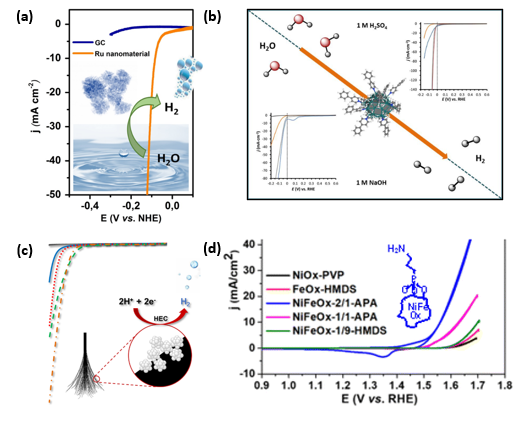
(a) HER catalyzed by a porous Ru nanomaterial (Chem. Commun. 2017, 53(85), 11713 ; doi.org/10.1039/C7CC05615J); (b) RuNPs stabilized by a phenylpyridine (ACS Catal. 2018, 8, 11094 ; doi.org/10.1021/acscatal.8b03053); (c) a photocathode consisting of RuNPs deposited on carbon fibers (Eur. J. Inorg. Chem. 2019, 2071 ; doi.org/10.1039/D0CY00193G) ; (d) Synthesis of NiFeOx nanocatalysts from metal-organic precursors for the oxygen evolution reaction (Dalton Trans., 2022, 51, 11457-11466 (doi.org/10.1039/d2dt01370c)
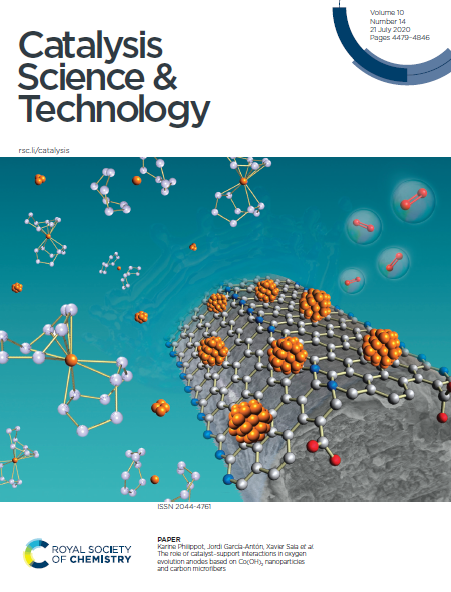
The role of catalyst-support interactions in oxygen evolution anodes based on Co(OH)2 nanoparticles and carbon microfibers, L. Mallón, N. Romero, A. Jiménez, E. Martin Morales, J. Alemán, R. Mas-Ballesté, R. Bofill, K. Philippot, J. García-Antón, X. Sala, Catal. Sci. Technol., 2020, 10, 4513-4521 (doi.org/10.1039/D0CY00193G).

Ru nanoparticles supported on alginate-derived graphene as hybrid electrodes for the hydrogen evolution reaction, L. Mallón, C. Cerezo-Navarrete, N. Romero, M. Puche, J. García-Antón, R. Bofill, K. Philippot, L. M. Martínez-Prieto, X. Sala, New J Chem., 2022, 46, 49-56 (doi.org/10.1039/D1NJ05215B).
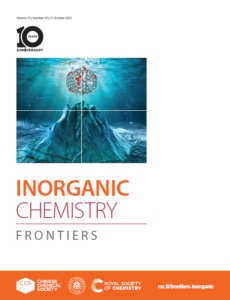
Ru-based nanoparticles in carbon nanotubes for electrocatalytic hydrogen evolution: structural and electronic effects, N. Romero, D. A. Fenoll, L. Gil, S. Campos, J. Creus, G. Martí, J. Heras-Domingo, V. Collière, C. A. Mesa, S. Giménez, L. Francàs, L. Rodríguez-Santiago, X. Solans-Monfort, M. Sodupe, R. Bofill, K. Philippot, J. García-Antón, X. Sala, Inorg. Chem. Front., 2023,10, 5885-5896 (doi.org/10.1039/D3QI00698K).
For photocatalysis applications,
we are developing nanohybrids that combine nanoparticles with complexes of the type [Ru(bpy)3]2+, capable of harvesting light energy to activate the reaction. These complexes are functionalized to have a solid interaction with the nanoparticles.
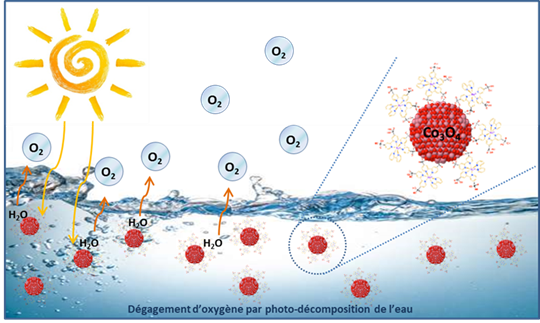
Light-driven water oxidation using hybrid photosensitizer-decorated Co3O4 nanoparticles, J. De Tovar, N. Romero, S. Denisov, R. Bofill, C. Gimbert-Suriñach, D. Ciuculescu-Pradines, S. Drouet, A. Llobet, P. Lecante, V. Colliere, Z. Freixa, N. McClenaghan, C. Amiens, J. García-Antón, K. Philippot, X. Sala, Materials Today Energy, 2018, 9, 506-515 (doi.org/10.1016/j.mtener.2018.07.008).

TiO2-mediated visible-light-driven hydrogen evolution by ligand-capped Ru nanoparticles, N. Romero, R. Guerra, L. Gil, S. Drouet, I. Salmeron, O. Illa, K. Philippot, M. Natali, J. García-Antón, X. Sala, Sustainable Energy & Fuels, 2020, 4, 4170-4178 (doi.org/10.1039/D0SE00446D).

Covalent grafting of ruthenium complexes on iron oxide nanoparticles: hybrid materials for photocatalytic water oxidation, Q. T. Nguyen, E. Rousset, V.T.H. Nguyen, V. Colliere, P. Lecante, W. Klysubun, K. Philippot, J. Esvan, M. Respaud, G. Lemercier, C. Amiens, P. D. Tran, ACS Applied Materials & Interfaces, 2021, 13, 4(45) 53829-53840. (doi.org/10.1021/acsami.1c15051).
In the fuel cells field,
the targeted reactions are methanol electrooxidation or oxygen reduction.
Synthesis of Rh nanoparticles in alcohols: magnetic and electrocatalytic properties, E. Ramírez-Meneses, K. Philippot, M.A. Domínguez-Crespo, M. Ibrahim, I. Betancourt, A.M. Torres Huerta, A. Ezeta-Mejia, L. Palacios-Romero, J. Mater. Sci., 2018, 53(12) 8933-8950 (doi.org/10.1007/s10853-018-2221-8).
Pd and Pd@PdO core–shell nanoparticles supported on Vulcan carbon XC-72R: comparison of electroactivity for methanol electro-oxidation reaction, E. Ramírez-Meneses, L.P.A. Guerrero-Ortega, R. Cabrera-Sierra, L.M. Palacios-Romero, K. Philippot, C.R. Santiago-Ramirez, L. Lartundo-Rojas, A. Manzo-Robledo, J. Mater. Sci., 2019, 54, 13694-13714 (doi.org/10.1007/s10853-019-03843-8).
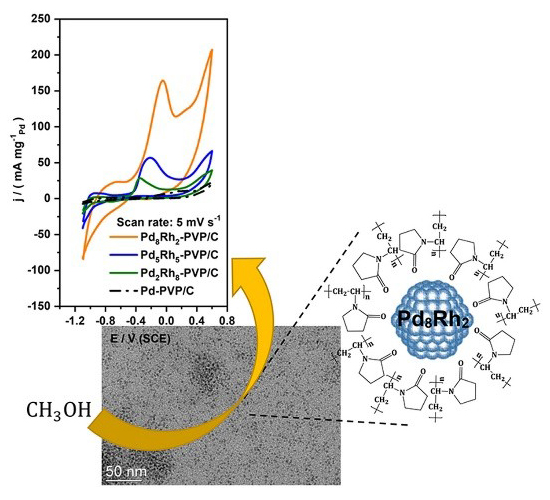
Improved methanol electro-oxidation reaction on PdRh-PVP/C electrodes, G. Zacahua-Tlacuatl, E. Ramírez-Meneses, A. Manzo-Robledo, A.M. Torres-Huerta, I. Betancourt, K. Philippot, M. Ibrahim, M.A. Domínguez-Crespo, Int. J. Hydrogen Energy 2023, 48, 23, 8450-8464 (doi.org/10.1016/j.ijhydene.2022.11.169).
These projects are conducted in collaboration with:
- In Toulouse: LPCNO (theoretical studies)
-
In Montpellier: ICGM (water electrolysis and fuel cells)
-
In Paris: SAFRAN (fuel cells)
-
In Reims: University of Reims (functionalized complexes of the type [Ru(bpy)3]2+)
-
In Spain: Universitat Autònoma de Barcelona (HER and OER by electrolysis and photocatalysis; theoretical studies)
-
In Mexico: Universidad Iberoamericana (fuel cells)
-
In Vietnam: University of Science and Technology of Hanoi (OER photocatalysis)
LCC CNRS
Laboratoire de chimie de coordination du CNRS
205 route de Narbonne, BP 44099
31077 Toulouse cedex 4
France




